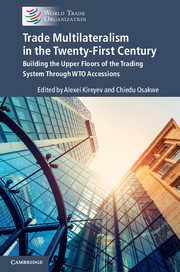 Trade Multilateralism in the Twenty-First Century
Trade Multilateralism in the Twenty-First Century Book contents
- Frontmatter
- Contents
- List of Plates
- List of Figures
- Notes on Contributors
- Foreword
- Acknowledgements
- List of Abbreviations
- Disclaimer
- 1 Making Trade Multilateralism Work for All: The Role of WTO Accessions
- PART I WTO Accessions and the New Trade Multilateralism
- PART II Negotiators’ Perspectives on the WTO Accession Process
- PART III Accessions Acquis: Thematic Perspectives and Implementation Challenges
- 13 How Post-TRIPS Negotiations Reframe the ‘Trade-Related Aspects’ of Intellectual Property after TRIPS: The Lessons of WTO Accessions
- 14 Competition Policy in WTO Accessions: Filling in the Blanks in the International Trading System
- 15 Geographical Indications in the Accessions Landscape
- 16 WTO Accession Commitments on Agriculture: Lessons for WTO Rule-Making
- 17 The WTO-Plus Obligations: Dual Class or a Strengthened System?
- 18 Accession Protocols and the Private Sector
- 19 Post-Accession Support Platform
- 20 Conclusion: Trade Multilateralism - Enhancing Flexibility, Preserving the Momentum
- Contributor Biographies
- Index
- References
15 - Geographical Indications in the Accessions Landscape
from PART III - Accessions Acquis: Thematic Perspectives and Implementation Challenges
Published online by Cambridge University Press: 28 November 2017
- Frontmatter
- Contents
- List of Plates
- List of Figures
- Notes on Contributors
- Foreword
- Acknowledgements
- List of Abbreviations
- Disclaimer
- 1 Making Trade Multilateralism Work for All: The Role of WTO Accessions
- PART I WTO Accessions and the New Trade Multilateralism
- PART II Negotiators’ Perspectives on the WTO Accession Process
- PART III Accessions Acquis: Thematic Perspectives and Implementation Challenges
- 13 How Post-TRIPS Negotiations Reframe the ‘Trade-Related Aspects’ of Intellectual Property after TRIPS: The Lessons of WTO Accessions
- 14 Competition Policy in WTO Accessions: Filling in the Blanks in the International Trading System
- 15 Geographical Indications in the Accessions Landscape
- 16 WTO Accession Commitments on Agriculture: Lessons for WTO Rule-Making
- 17 The WTO-Plus Obligations: Dual Class or a Strengthened System?
- 18 Accession Protocols and the Private Sector
- 19 Post-Accession Support Platform
- 20 Conclusion: Trade Multilateralism - Enhancing Flexibility, Preserving the Momentum
- Contributor Biographies
- Index
- References
Summary
Abstract
Geographical indications are signs used to identify the origin of goods characterized by a given quality or reputation that is essentially linked to their geographical origin. They preserve traditional knowledge, foster the growth of local production and satisfy the needs of increasingly quality-conscious and demanding global consumers. Governments acceding to the World Trade Organization (WTO) have reformed their rules on geographical indications in order to achieve WTO consistency. In doing so, they have added value to the multilateral trading system by clarifying the scope of WTO obligations in the field of geographical indications in the following ways: minimum standards of protection; requirements for application to geographical indication protection; the relationship between geographical indications and trademarks; and the scope of substantive provisions with regard to geographical indications. This heightened understanding of the regulation of geographical indications has set new standards in the multilateral trading system. Acceding economies have followed international best practices and sometimes gone a step further by undertaking commitments that exceed those in effect among incumbent WTO members. Rule-making on geographical indications has also helped to prevent disputes on related issues. The lessons learned in the WTO accession process can serve other developing countries and emerging economies to unravel the legal and economic potential of geographical indications.
The significance of geographical indications (GIs), such as ‘Champagne’, ‘Darjeeling tea’ and ‘café de Colombia’, has been increasing steadily. Not all products carry GIs, but those that do are called GI products. Worldwide sales of GI products – mainly wines and spirits – exceed US$ 50 billion annually (Giovannucci et al., 2009). GIs owe their origin to the fifteenth-century French concept of terroir – a distinct, identifiable quality reminiscent of a place, region or locality (Raustiala and Munzer, 2007). As the ‘distinct’ quality of the product is linked to a geographic location, GIs preserve traditional know-how and enhance local economic activity and rural development.
From an economic standpoint, a GI can be seen as a group asset. In general terms, a limited group of producers in a certain geographic area comes together on a voluntary basis in order to derive mutual benefits from sharing production costs, legal protection expenses and advertising, among others. To preserve the uniqueness of the GI, the group of producers, ‘the club’, has a finite membership (Benavente, 2010).
- Type
- Chapter
- Information
- Trade Multilateralism in the Twenty-First CenturyBuilding the Upper Floors of the Trading System through WTO Accessions, pp. 320 - 338Publisher: Cambridge University PressPrint publication year: 2017
